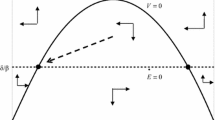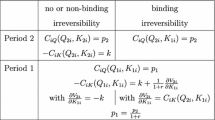Abstract
For the mitigation of long-term pollution threats, one must consider that both the process of environmental degradation and the switchover to new and cleaner technologies are dynamic. We develop a model of a uniform good that can be produced by either a polluting technology or a clean one; the latter is more expensive and requires investment in capacity. We derive the socially optimal pollution stock accumulation and creation of nonpolluting production capacity, weighing the tradeoffs among consumption, investment and djustment costs, and environmental damages. We consider the effects of changes in the pollution decay rate, the capacity depreciation rate, and the initial state of the environment on both the steady state and the transition period. The optimal transition path looks quite different with a clean or dirty initial environment. With the former, investment is slow and the price of pollution may overshoot the long-run optimum before converging. With the latter, capacity may overshoot.
Similar content being viewed by others
References
Feichtinger, Gustav, Andreas Novak and Franz Wirl (1994), ‘Limit Cycles in Intertemporal Adjustment Models’, Journal of Economic Dynamics and Control 18, 353–380.
Kolstad, Charles D. (1996), ‘Fundamental Irreversibilities in Stock Externalities’, Journal of Public Economics 60(2) (May 1996), 221–233.
Krautkraemer, Jeffrey A. (1985), ‘Optimal Growth, Resource Amenities and the Preservation of Natural Environments’, Review of Economic Studies LII, 153–170.
Léonard, Daniel and Ngo Van Long (1992), Optimal Control Theory and Static Optimization in Economics. Cambridge, UK: Cambridge University Press.
Michel, Philippe and Gilles Rotillon (1995), ‘Disutility of Pollution and Endogenous Growth’, Environmental and Resource Economics 6(3) (October 1995), 279–300.
Narain, Urvashi and Anthony Fisher (2002), ‘Irreversibility, Uncertainty, and Global Warming: A Theoretical Analysis’, Environmental and Resource Economics, forthcoming.
Oren, Shmuel and Stephen Powell (1985), ‘Optimal Supply of a Depletable Resource with a Backstop Technology: Heal's Theorem Revisited’, Operations Research 33(2) (March-April).
Switzer, Sheldon and Stephen Salant (1986), ‘Optimal Capacity Expansion by Foresighted Extractors and Producers’ ('Expansion optimale de capacité par des exploitants prévoyants d'une ressource renouvelable'), in Gérard Gaudet and Pierre Laserre, eds., Ressources Naturelles et Théorie Economique. Laval, Quebec: University of Laval Press.
Toman, Michael A. and Cees Withagen (2000), ‘Accumulative Pollution, “Clean Technology” and Policy Design’, Resource and Energy Economics 22, 367–384.
Ulph, Alistair and David Ulph (1997), ‘Global Warming, Irreversibility and Learning’, Economic Journal 107(442) (May 1997), 636–650.
Wirl, Franz and Cees Withagen (2000), ‘Complexities Due to Sluggish Expansion of Backstop Technologies’, Journal of Economics 72, 153–174.
Author information
Authors and Affiliations
Corresponding author
Rights and permissions
About this article
Cite this article
Fischer, C., Withagen, C. & Toman, M. Optimal Investment in Clean Production Capacity. Environmental and Resource Economics 28, 325–345 (2004). https://doi.org/10.1023/B:EARE.0000031057.52949.01
Issue Date:
DOI: https://doi.org/10.1023/B:EARE.0000031057.52949.01




